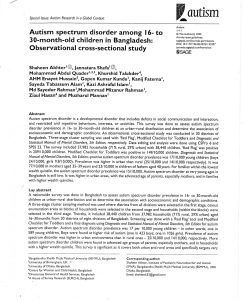
Signs of ASD are typically detected in early childhood, with boys four to five times more frequently diagnosed with ASD than girls. Prevalence of ASD has been increasing worldwide. It has been reported to be as high as 168 per 10,000 or 1/59 in 8-year-old children in the USA in 2014.
Like many other developing countries, Bangladesh has very little data on how many children or adults suffer from ASD or any life-long debilitating developmental neurological condition. However, some scattered and small-scale research and surveys have been done on autism. One of these is the Bangladesh Population and Housing Census 2011, which documented the population of those with disabilities, including autism at all ages. However, that process did not use M-CHAT or scientific screening of the autistic population; it only recorded all types of disabilities.
The aim of this survey was to help the different stakeholders of the Government of Bangladesh Including BSMMU and other national and international organizations working in this field for policy making, program planning and interventions. The survey was focused on children, aged 16-30 months in order to find the national numbers regarding children with ASD. The aim of selecting such young children was to bring them under interventions at an early stage.
Results
The survey was undertaken in 37,982 households (71% rural, 29% urban) of 30 districts across eight divisions and containing 38,440 children (52% boys, 48% girls) aged 16-30 months. Almost 36% all household populations aged six years or above were involved in housework, just over 29% were students, 13% were involved in agriculture, 8.3% in business, 5% in production/transport and 4.3% in other professions.
Prevalence of Autism Spectrum Disorder (ASD)
Red Flag screen was positive in 209 per 10,000 young children (boys 242; girls 172). M-CHAT screen was positive in 149 per 10,000 young children (boys 174; girls 122). DSM-5 positive ASD prevalence was 17 per 10,000 young children (boys 24/10,000, girls 9.8/10,000) – in other words 1 in 589 young children (1 in 423 boys; 1 in 1,026 girls). Rural prevalence was 14/10,000 and urban 25/10,000.




 IPNA wants to create a world where children with developmental disabilities and their parents can get their questions answered and their needs met in a caring environment.
IPNA wants to create a world where children with developmental disabilities and their parents can get their questions answered and their needs met in a caring environment.